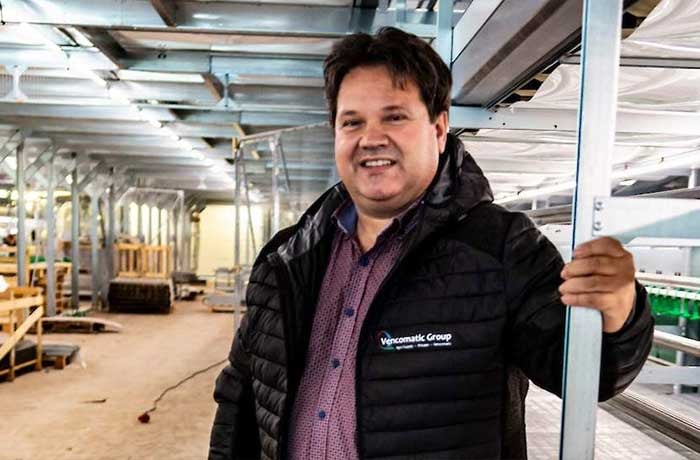Eric Hubers (53) has been chairman of the department of poultry farming at LTO/NOP for seven years now. He considers it essential that the interests of the sector are represented by someone who really knows what he is talking about, because these are often complex subjects. Eric: "My motto is 'by and for farmers'. After all, you can only represent the interests of poultry farmers well and effectively if you are also a poultry farmer yourself".
Extremely interesting
The departmental chairmanship costs Eric a lot of time and energy, but he also finds it extremely interesting. "You talk to governments, NGOs, animal rights organisations, you name it. You get to beautiful places and in special circumstances. As with the last outbreak of H5N8; then I unexpectedly sat at the table with the king. Willem-Alexander wanted to know exactly what the current situation was with bird flu. So it's nice work, but because of the great responsibility it's also difficult. When Eric talks to the minister, he feels the high pressure. "You want to do it well because there is a lot at stake. Everyone is pulling you; you are being claimed by everything and everyone. Particularly in a crisis such as bird flu or fipronil, it's pretty heavy".
Poultry Business
Thanks to his wife Marga (55), Eric succeeds in being not only a department president but also a keeper of laying hens. "Thanks to the Presidency, I have been away from home for the last seven years. Marga does most of the work. We have this poultry farm together, but Marga is actually the director of our company". The fact that all three children are now a little older also makes it easier. The youngest is 21 and is studying animal science in Wageningen; that may be the successor, but for the time being Marga and Eric will continue their business.
Well thought out
Until April 2019, the Hubers family had five houses with 125,000 laying hens. Because they have been given a wider permit in 2018, they can go up to 135,000 hens. For this purpose, two houses were removed and replaced by one large one. This creates space for 70,000 free-range and 65,000 free-range birds. For the five older houses - two of which have now been demolished - Eric opted for the RED-L system at the time. "Twenty years ago I went to see Lammy and Roelof Pol, the inventors of RED-L. I thought: 'They gave it a lot of thought'. It was all very new at the time, but I immediately had confidence in it and wanted to take any teething problems for granted".
As in nature
It was not so bad with these teething troubles, by the way. However, it was necessary to learn exactly how chickens behave in this aviary system. For example, they locked up the chickens in this system with nets and wire netting so that they could not get on the ground, but that was not necessary at all. Eric: "We were used to that locking up from the cage systems. We wondered whether the hens would do what they had to do if they were on the ground. Now we only lock them up at the beginnin,g so that they can't get under the system on the ground".
What immediately struck us was that the hens can move safely and easily through the system. In a row system the animals move vertically from level to level, but in RED-L they jump straight ahead from layer to layer without too much effort as they do in nature. "Chickens at the end of the round in particular benefit from this. Recently the last hens left at 97 weeks of age and for these less vital animals it is nice to be able to jump from layer to layer easily".
Good overview
Eric also mentions as an advantage that RED-L is a portal system with few piles. "Few piles require a large span and that is only possible if you use a heavy frame. We therefore see a heavy construction that lasts a long time. But few piles means above all a lot of space on the floor and free movement for the birds: the laying hens can walk reasonably freely on the ground from one side of the barn to the other, while it is easy for us to clean it". Eric has good access to everything and he also likes the overview RED-L gives him: "The structure of the system makes it easy to control the flock. First I look upstairs and then I look at everything from the ground; after that I have seen it all clearly".
Q-Perch
Eric is satisfied with the RED-L. However, it was not entirely certain that RED-L would once again become the system for the large new barn that replaces the two older barns. "During the construction of our new barn, I once again started to orient myself towards the aviary systems on the market. There are good other systems available from Dutch suppliers. But in the end I opted for RED-L again; the good experiences with the system in my barns were the deciding factor. Moreover, the latest generation of RED-L can also be equipped with Q-Perch, the mushroom-shaped perch with a wire at the bottom on two sides that paralyses red mites.
Collaboration
The Hubers family is building the latest generation of RED-L under its own management in its new house. Eric: "We do it ourselves but we are also supported by Vencomatic Group. There is interim coordination, consultation about the design and possible adjustments". Eric also thinks it's logical that the collaboration is going so well because he and Vencomatic Group have known each other for twenty years. "I regularly see that technicians from the first hour are now working in the field. Yes, they know exactly what they're talking about and that's why things are running smoothly with the installation of RED-L in our new barn: in consultation with Vencomatic Group, in our own way".












.png?width=160&height=132&name=Egg%20packers%20-%20Vencomatic%20Group%20(2).png)
.png?width=160&height=132&name=Meggsius%20Select%20-%20Vencomatic%20Group%20(2).png)














